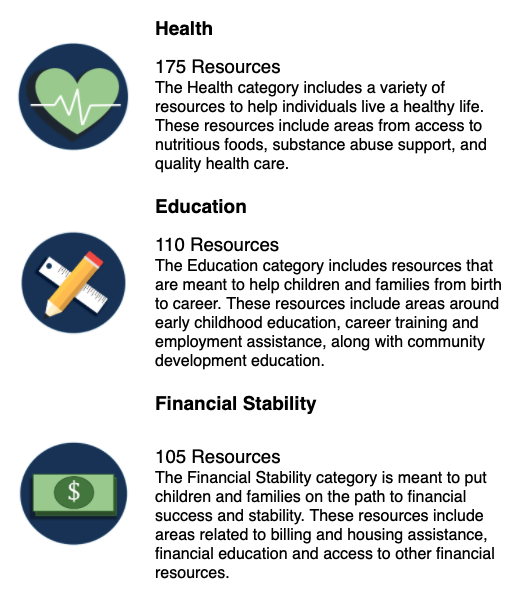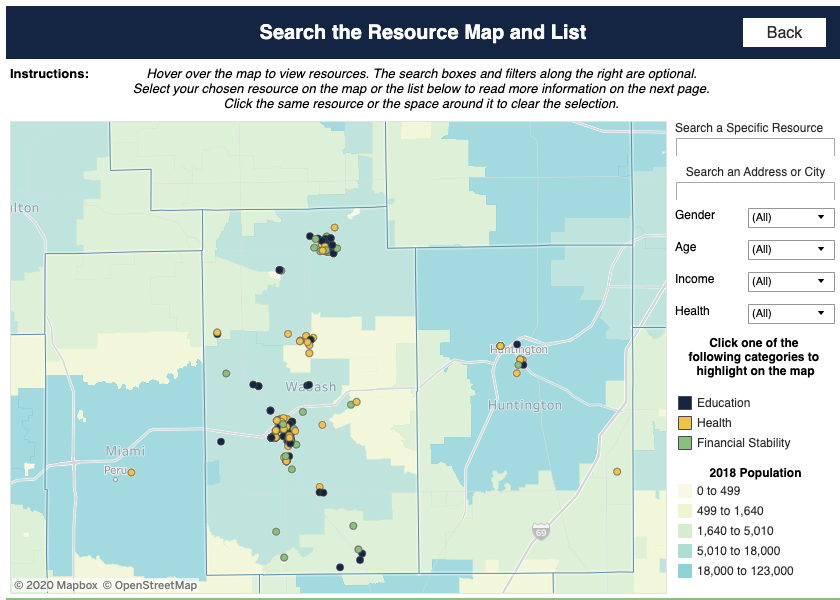Are you a community leader working to provide more information about availability of services in your county? Maybe you are trying to identify coverage areas, gaps in services or duplications of services in the non-profit sector of your community? We believe an asset map is the perfect solution.

We first shared tips for building an asset map in this blog featuring a resource we created for the United Fund of Wabash County. This particular map is geared to help professionals, programs, and other community partners identify resources available for support and collaboration, along with providing an opportunity to identify gaps in the community. The map organizes Wabash County resources by three main categories: Health, Education, or Financial Stability. These three categories are the United Fund’s core areas of focus.
When utilizing the asset map, visitors can select one of the three main categories, followed by a secondary category to narrow down his or her search. For example, by selecting the Health category you’ll see all of the resources related to nutrition, support groups, and medical assistance. If a visitor doesn’t know what category to search under, they can use the map feature to search by keyword and other filters, or hover over the map to see information for all resources nearby.

As mentioned previously, the United Fund asset map was originally created in 2019. A year later it is still a valuable resource, but maintenance is required. In order to fully maximize an asset map, you have to be ready for regular updates to ensure visitors are always viewing the most up-to-date information.
Our team at Transform Consulting Group has been busy updating the United Fund asset map and learned a few things along the way. Here are four tips for keeping your asset map current:
- Track Information: We use Tableau Software to create the interactive dashboard that the public sees. However, all the data is linked to a working spreadsheet. The spreadsheet tracks history, and offers search and filter options to locate information, but not everyone needs access to the original source. If someone in the public wants to add, update, or remove a resource they should contact the organization that monitors the original spreadsheet. It is convenient to have all of this in one place as it makes updating and tracking much easier.
- Add and Update Resources: We recommend starting with your current list and ensure information is correct through regular maintenance checks. Depending on staff capacity, develop a maintenance schedule. For example, you may plan to review at the end of each month or every quarter. To help your search, check out resource lists other community wide organizations already have, like the local community foundation posting a list of funding organizations in the area.
- Refine Resources: The Wabash County United Fund list has over 300 resources! A primary and secondary category helps group resources to make something easier to find, but we found the secondary categories start to increase with the list. Some may be similar, which gives you an opportunity to refine the groups. On our asset map, we had separate columns for “Housing” and “Housing Resources” which can be considered two different things, but they can also be combined to reduce clutter on the interface.
- Seek feedback: Don’t do it alone. Like we mentioned, our list has over 300 resources. It can be difficult to manage that number and stay up to date with the changing information. Ask the community for feedback by having a contact form visible with the dashboard, and/ or send an annual survey to resources on the list and additional community leaders to find out if their information is current.
Do you have an asset map that needs updated? Or maybe you need to start the process from scratch of organizing resources into an asset map for your community? We’d love to hear from you and help!
